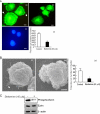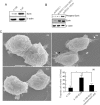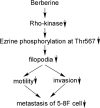Berberine inhibits metastasis of nasopharyngeal carcinoma 5-8F cells by targeting Rho kinase-mediated Ezrin phosphorylation at threonine 567
- PMID: 19651779
- PMCID: PMC2785675
- DOI: 10.1074/jbc.M109.033795
Berberine inhibits metastasis of nasopharyngeal carcinoma 5-8F cells by targeting Rho kinase-mediated Ezrin phosphorylation at threonine 567
Abstract
Ezrin is highly expressed in metastatic tumors and is involved in filopodia formation as well as promotion of tumor metastasis. Thus, Ezrin may serve as a potential target for anti-metastatic therapy. This study demonstrates that berberine reduces filopodia formation of a nasopharyngeal carcinoma (NPC) cell line, 5-8F, at non-cytotoxic concentrations. Furthermore, invasion and motility of 5-8F cells are decreased in a dose- and time-dependent manner, resulting in 73.0% invasion and 67.0% motility inhibition at 20 mum. The inhibitory effects of berberine on 5-8F cell metastasis were further confirmed in a mouse model of metastasis. Berberine treatment in vivo resulted in a 51.1% inhibition of tumor metastasis to the lymph nodes and decreased Ezrin phosphorylation at threonine 567 in metastatic samples. Berberine suppressed the presence of phosphorylated Ezrin (phospho-Ezrin) in a dose- and time-dependent manner but had no effect on total Ezrin protein expression at non-cytotoxic concentrations. Furthermore, the inhibitory effects of berberine on phospho-Ezrin were dependent on the suppression of Rho kinase activity. Reduction of Ezrin phosphorylation at Thr(567) by berberine was associated with its inhibitory effect on filopodia formation in 5-8F cells. However, berberine did not effectively inhibit the motility and invasion of NPC cells containing Ezrin Thr(567) mutants. These results confirm that berberine inhibits Ezrin phosphorylation at Thr(567). Nonetheless, berberine reduces motility and invasion of cells and inhibits tumor metastasis. The reduction of Rho kinase-mediated Ezrin phosphorylation mediated by berberine may be a novel anti-metastatic pathway in NPC 5-8F cells.
Figures










References
-
- Miaczynska M., Pelkmans L., Zerial M. (2004) Curr. Opin. Cell Biol. 16, 400–406 - PubMed
-
- Saotome I., Curto M., McClatchey A. I. (2004) Dev. Cell 6, 855–864 - PubMed
-
- Faure S., Salazar-Fontana L. I., Semichon M., Tybulewicz V. L., Bismuth G., Trautmann A., Germain R. N., Delon J. (2004) Nat. Immunol. 5, 272–279 - PubMed
Publication types
MeSH terms
Substances
LinkOut - more resources
Full Text Sources
Molecular Biology Databases

